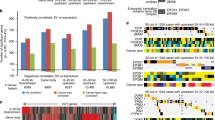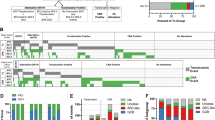Abstract
p53-Binding protein 1 (53BP1) encodes a critical checkpoint protein that localizes to sites of DNA double-strand breaks (DSBs) and participates in DSB repair. Mice that are 53bp1 deficient or hemizygous have an increased incidence of lymphoid malignancies. However, 53BP1 abnormalities in primary human tumors have not been described. By combining high-density single nucleotide polymorphism (HD SNP) array data and gene expression profiles, we found 9 of 63 newly diagnosed human diffuse large B-cell lymphomas (DLBCLs) with single copy loss of the chromosome 15q15 region including the 53BP1 locus; these nine tumors also had significantly lower levels of 53BP1 transcripts. 53BP1 single copy loss found with the HD SNP array platform was subsequently confirmed by fluorescence in situ hybridization. These studies highlight the role of 53BP1 copy loss in primary human DLBCLs and the value of integrative analyses in detecting this genetic lesion in human tumors.
This is a preview of subscription content, access via your institution
Access options
Subscribe to this journal
Receive 50 print issues and online access
$259.00 per year
only $5.18 per issue
Buy this article
- Purchase on Springer Link
- Instant access to full article PDF
Prices may be subject to local taxes which are calculated during checkout



Similar content being viewed by others
References
Adams MM, Carpenter PB . (2006). Tying the loose ends together in DNA double strand break repair with 53BP1. Cell Div 1: 19.
Benjamini Y, Hochberg Y . (1995). Controlling the False Discovery Rate: A Practical and Powerful Approach to Multiple Testing. J R Statist Soc B 57: 289–300.
Beroukhim R, Getz G, Nghiemphu L, Barretina J, Hsueh T, Linhart D et al. Genome-wide analysis of chromosomal aberrations in glioma. (Submitted).
Chaudhuri J, Alt FW . (2004). Class-switch recombination: interplay of transcription, DNA deamination and DNA repair. Nat Rev Immunol 4: 541–552.
Conrad DF, Andrews TD, Carter NP, Hurles ME, Pritchard JK . (2006). A high-resolution survey of deletion polymorphism in the human genome. Nat Genet 38: 75–81.
Fodde R, Smits R . (2002). Cancer biology A matter of dosage. Science 298: 761–763.
Franco S, Alt FW, Manis JP . (2006a). Pathways that suppress programmed DNA breaks from progressing to chromosomal breaks and translocations. DNA Repair 5: 1030–1041.
Franco S, Gostissa M, Zha S, Lombard DB, Murphy MM, Zarrin AA et al. (2006b). H2AX prevents DNA breaks from progressing to chromosome breaks and translocations. Mol Cell 21: 201–214.
Garraway LA, Widlund HR, Rubin MA, Getz G, Berger AJ, Ramaswamy S et al. (2005). Integrative genomic analyses identify MITF as a lineage survival oncogene amplified in malignant melanoma. Nature 436: 117–122.
Gorgoulis VG, Vassiliou LV, Karakaidos P, Zacharatos P, Kotsinas A, Liloglou T et al. (2005). Activation of the DNA damage checkpoint and genomic instability in human precancerous lesions. Nature 434: 907–913.
Hupe P, Stransky N, Thiery JP, Radvanyi F, Barillot E . (2004). Analysis of array CGH data: from signal ratio to gain and loss of DNA regions. Bioinformatics 20: 3413–3422.
Iafrate AJ, Feuk L, Rivera MN, Listewnik ML, Donahoe PK, Qi Y et al. (2004). Detection of large-scale variation in the human genome. Nat Genet 36: 949–951.
Li C, Wong WH . (2001). Model-based analysis of oligonucleotide arrays: expression index computation and outlier detection. Proc Natl Acad Sci USA 98: 31–36.
Lin M, Wei LJ, Sellers WR, Lieberfarb M, Wong WH, Li C . (2004). dChipSNP: significance curve and clustering of SNP-array-based loss-of-heterozygosity data. Bioinformatics 20: 1233–1240.
Manis JP, Morales JC, Xia Z, Kutok JL, Alt FW, Carpenter PB . (2004). 53BP1 links DNA damage-response pathways to immunoglobulin heavy chain class-switch recombination. Nat Immunol 5: 481–487.
McCarroll SA, Hadnott TN, Perry GH, Sabeti PC, Zody MC, Barrett JC et al. (2006). Common deletion polymorphisms in the human genome. Nat Genet 38: 86–92.
Mochan TA, Venere M, DiTullio Jr RA, Halazonetis TD . (2004). 53BP1, an activator of ATM in response to DNA damage. DNA Repair 3: 945–952.
Monti S, Savage KJ, Kutok JL, Feuerhake F, Kurtin P, Mihm M et al. (2005). Molecular profiling of diffuse large B-cell lymphoma identifies robust subtypes including one characterized by host inflammatory response. Blood 105: 1851–1861.
Morales JC, Franco S, Murphy MM, Bassing CH, Mills KD, Adams MM et al. (2006). 53BP1 and p53 synergize to suppress genomic instability and lymphomagenesis. Proc Natl Acad Sci USA 103: 3310–3315.
Phan RT, Dalla-Favera R . (2004). The BCL6 proto-oncogene suppresses p53 expression in germinal-centre B cells. Nature 432: 635–639.
Phan RT, Saito M, Basso K, Niu H, Dalla-Favera R . (2005). BCL6 interacts with the transcription factor Miz-1 to suppress the cyclin-dependent kinase inhibitor p21 and cell cycle arrest in germinal center B cells. Nat Immunol 6: 1054–1060.
Polo JM, Juszczynski P, Monti S, Cerchietti L, Ye K, Greally JM et al. (2007). A transcriptional signature with differential expression of BCL6 target genes accurately identifies BCL6-dependent diffuse large B-cell lymphomas. Proc Natl Acad Sci USA 104: 3207–3212.
Redon R, Ishikawa S, Fitch KR, Feuk L, Perry GH, Andrews TD et al. (2006). Global variation in copy number in the human genome. Nature 444: 444–454.
Storey JD . (2002). A direct approach to false discovery rates. J Roy Statisti Soc B 64: 479–498.
Takahashi H, Feuerhake F, Kutok JL, Monti S, Dal Cin P, Neuberg D et al. (2006). FAS death domain deletions and cellular FADD-like interleukin 1beta converting enzyme inhibitory protein (long) overexpression: alternative mechanisms for deregulating the extrinsic apoptotic pathway in diffuse large B-cell lymphoma subtypes. Clin Cancer Res 12: 3265–3271.
Ward IM, Difilippantonio S, Minn K, Mueller MD, Molina JR, Yu X et al. (2005). 53BP1 cooperates with p53 and functions as a haploinsufficient tumor suppressor in mice. Mol Cell Biol 25: 10079–10086.
Ward IM, Minn K, Jorda KG, Chen J . (2003a). Accumulation of checkpoint protein 53BP1 at DNA breaks involves its binding to phosphorylated histone H2AX. J Biol Chem 278: 19579–19582.
Ward IM, Minn K, van Deursen J, Chen J . (2003b). p53 Binding protein 53BP1 is required for DNA damage responses and tumor suppression in mice. Mol Cell Biol 23: 2556–2563.
Wu X, Jelinek DF . (2005). A-Miz-ing BCL6. Nat Immunol 6: 964–966.
Zhao X, Li C, Paez JG, Chin K, Janne PA, Chen TH et al. (2004). An integrated view of copy number and allelic alterations in the cancer genome using single nucleotide polymorphism arrays. Cancer Res 64: 3060–3071.
Acknowledgements
This study was supported by grants from National Cancer Institute PO1 CA92625 (KT, SM, JM, JA, FA, TG, MS) and Department of Defense PC040638 (RB).
Author information
Authors and Affiliations
Corresponding author
Additional information
Supplementary Information accompanies the paper on the Oncogene website (http://www.nature.com/onc).
Supplementary information
Rights and permissions
About this article
Cite this article
Takeyama, K., Monti, S., Manis, J. et al. Integrative analysis reveals 53BP1 copy loss and decreased expression in a subset of human diffuse large B-cell lymphomas. Oncogene 27, 318–322 (2008). https://doi.org/10.1038/sj.onc.1210650
Received:
Revised:
Accepted:
Published:
Issue Date:
DOI: https://doi.org/10.1038/sj.onc.1210650
Keywords
This article is cited by
-
Charity begins at home: non-coding RNA functions in DNA repair
Nature Reviews Molecular Cell Biology (2013)



